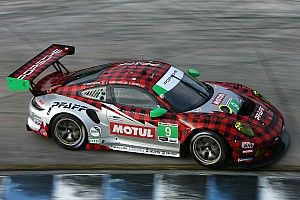Pilet lands Rolex 24 drive with Pfaff GTD squad
Patrick Pilet has secured a drive for the IMSA WeatherTech SportsCar Championship season-opening Rolex 24 Hours at Daytona with the Pfaff Porsche team.

Photo by: Pfaff Motorsports
Pilet was named as Pfaff's fourth driver for next month's Florida endurance classic in the #9 Porsche 911 GT3 R alongside Zach Robichon, Dennis Olsen and Lars Kern, who will bid for GT Daytona class honours together.
It follows last weekend's news that Pilet has been axed from the factory Porsche IMSA team in favour of Frederic Makowiecki for the 2020 campaign.
The 38-year-old, who had been Nick Tandy's partner in the #911 car since 2015, will however be part of Porsche's Intercontinental GT Challenge programme in 2020.
Olsen, this year's IGTC drivers' champion, was not listed among Porsche's 18 official factory drivers when the list was revealed on Saturday night.
The Norwegian however will contest the full IMSA season with Pfaff alongside Robichon, having made two outings for the team this year at Daytona and Lime Rock Park.
Kern meanwhile reprises his role as the 'third driver' for the Canadian outfit for the four Michelin Endurance Cup races at Daytona, Sebring, Watkins Glen and Road Atlanta.
French oil company Motul has joined Pfaff as a primary sponsor for the #9 Porsche, which otherwise retains its distinctive plaid livery.

#9 Pfaff Motorsports Porsche 911 GT3 R: Patrick Pilet, Zacharie Robichon, Dennis Olsen, Lars Kern
Photo by: Pfaff Motorsports
Be part of Motorsport community
Join the conversationShare Or Save This Story
Subscribe and access Motorsport.com with your ad-blocker.
From Formula 1 to MotoGP we report straight from the paddock because we love our sport, just like you. In order to keep delivering our expert journalism, our website uses advertising. Still, we want to give you the opportunity to enjoy an ad-free and tracker-free website and to continue using your adblocker.























Top Comments